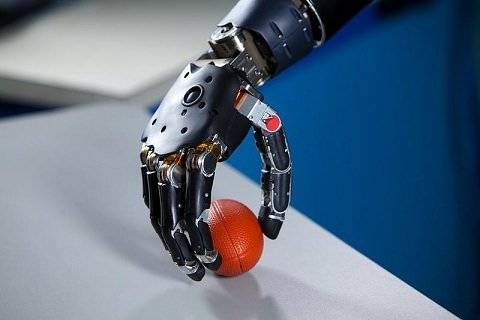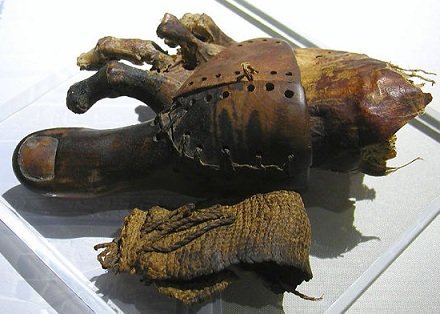Would The Touch-Sensitive Prosthetics Be The Future Of Bionic Augmentation?
Introduction
What's the commonest and most viable solution to a missing or decapitated limb? Well, since the human limbs are not like that of the Starfish or Axolotl (that can grow new ones), prosthesis would suffice. But before now, these are just seen as some bunch of mechanical aids to replace the normal biological limbs. But as technology keeps advancing, complexities keep on arriving in the area of prosthetic augmentation. Just some months ago, we saw an Olympic sprint runner wowing the world with his carbon-fiber prosthetic blade (though some have speculated that it may have handed over some extra advantages over the normal biological leg to him). How human! The augmentation that was initially meant to serve as therapeutic aid is now seen to have an edge over biology. But in all these; one aspect has been lacking in the field of prosthetics, and that is; "Touch reception". So what plans are there to make people with prostheses feel what we feel?

[Image Source: Wikimedia Commons. Author: FDA. Public Domain Licensed]
The Trail
Prosthetics are not particularly new to this era; as a matter of precision, they have been around for millennia, and even very recently, according to this report, an ancient prosthetic leg was excavated - and on carbon-dating, it was discovered that it was created around 300BC; imagine the ancient ingenuity of humans. Also, if you're familiar with history, you may have heard of the historic female warrior; "Vishpala"; who lost her leg in a combat, and an artificial leg was created to replace the leg; this was about 1200BC [ref] - even though there are not too many references to substantiate the claims, but this is just to let you know that prosthetics have been age-long. This was how the journey began, and in this era, we've been witnessing mind-blowing bionics.
Before I continue, here's a little tip for you: Though the term "prosthetics" and "Bionics" are used interchangeably (particularly by the uninitiated), there's a little difference between them. Prosthetics could mean any augmentation to serve as therapeutic aid for a missing part of the body - Like the carbon-fibre blade to replace a missing leg. But Bionics are seen as the prosthetics that are powered either mechanically, electrically, electronically, even bio-mechanically (for the newer advances), or combination of two of more of the aforementioned; and these are often made to simulate the function of the normal biological body part to a detailed precision. So by inference; bionics can also be called prosthetics, but a prosthesis may not be a bionic if it is not powered by any of the aforementioned.
It is also worthy to note that bionics and prosthetics go way beyond limb augmentation; we've also seen other parts being augmented (like the Cochlear implant, et al), and with the advances in tech, almost every body part could be replaceable in the nearest future... quote me. Still on the ancient prosthetics; it might interest you to know that a particular prosthetic toe was discovered; The Cairo Toe; and paleontological analysis has shown that the toe dated over 3millenia - which means; this can be inferred to be among the earliest prosthetics (if not the earliest) known to man.

[Image Source: Wikimedia Commons. Author: Jon Bodsworth. CC0 Licensed]
But in all these, the very crucial part of the human body; the touch-reception: is missing here. But with the advent of Artificial Intelligence (tasked with the function of simulating the human abilities in machines), the idea of incorporating touch receptors in prosthetics has found the light of the day.
The present and the future
When a pin pricks your hand, what do you feel? Pain right? Okay, when someone steps on your toes, you'll feel the pressure right? What if I tell you that pain, pressure, or touch generally, can be replicated in prosthetics, would you believe me? Just hang on. An idea was heralded by some groups of researchers from the North Carolina State University, in conjunction with the University of North Carolina, to tweak prosthetics with bio-sensors (such as it is found in the human skin). But for this to work, the prosthetics would be built with biosynthetic materials; the kind used to create the biohybrid robot (we've discussed about biohybrid robot, and you can get a baseline info from this post).
The work of this biosynthetic material is to act as the normal biological skin of the organic humans, which would also be linked directly to the brain through some neural interconnections. Maybe we'll need to thank BCI (Brain-Computer Interface) for providing us with the platform for this. So this is just like linking the prosthetics to the brain; but not just for controlling of the prosthetics, but for sensation. This is also the platform upon which neuroprosthetics are designed. Also, to further simulate the effect of the biological skin; in addition to the bio-sensors in the prosthetics; electromyography sensors are incorporated too.
We may have already known that electromyogram deals with the electric impulses or actions by the body's skeletal muscles. So by incorporating electromyography sensors into prosthetics; just like the skin and muscles; touches can be picked up and transmitted to the brain (through the neural networks) as electrical impulses, for it to be interpreted as either pain, pressure, and all whatnot. But just to amaze you, these sensors can even go way beyond picking up touches to picking up changes in temperatures (hot, cold). Isn't technology really amazing? Maybe you'll need to take a little peek into this YouTube video of a very smart prosthesis.
[Video Credit: Freethink]
Artificial Intelligence + Neuroscience + Prosthetics
Now this is sounding like we're building some humans with extrahuman abilities; but in the real sense, we actually are. You've probably heard of the controlling of prosthetics with the mind (at least I mentioned that earlier), but much more than that, a particular prosthesis has been created to simulate hundreds of these micro touches; just like the human skin - I present to you the beast; "LUKE Prosthetics". Wassup with the name "LUKE"? If you're familiar with the Star Wars movies, you may have seen the episode; "The Force Awakens"; a particular character; Luke Skywalker had a uniquely advanced prosthetic limb - and that was the inspiration for the creation and naming of the prosthetics; LUKE.
Unlike the other touch-sensitive prosthetics that detect touches, LUKE can even distinguish; to a very high precision index; the degree and level of the touches (light touch, pressure, etc) - and the big one; it can literally feel pain - That is; it can sense a touch (that would suffice for a pain), and sends the data to the brain, which would be interpreted as pain, and the required responses would be initiated. In other words; it is just like artificially simulating "pain" in the prosthetics.
Remember when the speculation was raised that humans would merge with machines; some people looked at it as a fairy tale, but this is already what is happening. And the augments (people with prosthetic augmentation) can be called Cyborgs (Cybernetic Organisms). I mean; this is not like the "living-tissues-over-metal-skeleton" kind of cyborg, but the merger of biology and technology - just like it is shown in the case of LUKE.
[Video Credit: DARPAtv]
So as it were, the properties that have been the absolute prerogative of our normal biological body parts are now finding simulations by machines and bionic/prosthetic augmentation. Maybe a time could come where even the brain of the humans can be replaced by prosthetics - the future would tell though.
Conclusion
Prosthetics have remained one of the feasible solutions in the replacement of missing body parts (particularly the limbs), which started off as woods, metals, and all whatnot. Before now these were seen as some bunch of hardwares, but with the advances in tech, complexities have arisen in this field, and we've seen the creation of prosthetics that can be sensitive to touch - what can't technology do?
Thanks for reading
References for further reading:
- History of Prosthetics
- Biohybrid Robotics – Creating a Cyborg
- LUKE Prosthetics – the details
- Bionics with feeling
All Images are CC Licensed and are linked to their sources


gif by @foundation
This post has been rated by the user-run curation platform CI! In this platform users are able to manually curate content. This is done regardless of Steem Power, for both rewards and vote size calculation.
Join in at our site here!
https://collectiveintelligence.red/
Or join us on discord to interact with the community!
https://discord.gg/sx6dYxt
This post was submitted for curation by: @anevolvedmonkey
This post was given a rating of: 0.9945581248172355
This post was voted: 82.78%
Thanks a lot co-in, I'm grateful.
Also, thanks to @anevolvedmonkey for the honour :)
Nice write up Sam. So the theory of cyborgs we see in the movie is truly coming to past abi.
The mention of super humans with the introduction of the advanced prosthetic got me thinking: Why not we all cut our hands and get prosthetics attached, then we could all be super humans. lols.... (anyways just me thinking)
Hope to read about more improvements on this soon
Lol.. That could work though... or we can add the prosthetics to the natural hand. It wouldn't hurt to have three functional hands :D
Hahaha. Three hands. Wow
Looking forward to seeing the next developments in this field and seeing the first prosthetics with the ability to recognize the texture and temperature of the material emerge.
Great post ! Thanks :)
Prosthetics that would have the ability to recognize the texture of materials? Wow! That would be a milestone achievement. I believe the possibility would arrive soon.
Thanks buddy
This post has been voted on by the steemstem curation team and voting trail.
There is more to SteemSTEM than just writing posts, check here for some more tips on being a community member. You can also join our discord here to get to know the rest of the community!